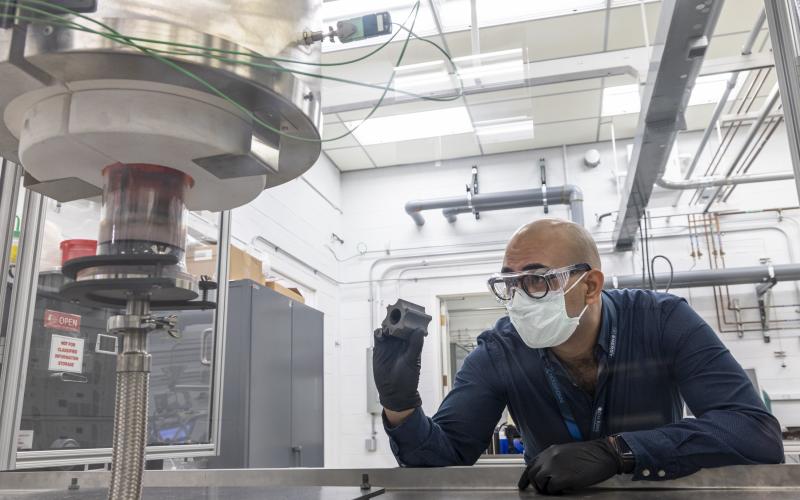While it will take decades and a great deal of upheaval for the world to transition away from fossil fuels, that transition is underway. Among the slew of energy looking to reshape how we power global society is nuclear. However, for fission to fill the massive footprint of carbon, the technology will require significant advances. That’s why Ultra Safe Nuclear Corporation has cut the ribbon on its Pilot Fuel Manufacturing (PFM) facility in Oak Ridge, Tenn. to create fuel for use in its Micro Modular Reactor (MMR) energy system.
Ultra Safe’s Pilot Fuel Manufacturing Facility
On August 19, 2022, the Seattle-based firm held the grand opening of its new site, located in the East Tennessee Technology Park (ETTP), which took just 12 months to design and build. In attendance were Tennessee Lieutenant Governor Randy McNally, Congressman Chuck Fleischmann (TN-03), Assistant Secretary for Nuclear Energy Dr. Kathryn Huff, and representatives from the offices of Senators Marsha Blackburn and Bill Hagerty. So far, the operation has generated over 40 skilled jobs.

The ribbon-cutting ceremony for Ultra Safe Nuclear Corporation’s Pilot Fuel Manufacturing in Oak Ridge, Tennessee. Image courtesy of Ultra Safe Nuclear Corporation.
Binder jet 3D printing from Desktop Metal is key to the company’s nuclear fuel. Using a technique licensed from Oak Ridge National Laboratory, Ultra Safe Nuclear 3D prints radiation-tolerant, heat-resistant silicon carbide casing for its nuclear fuel, made up of TRi-structural ISOtropic (TRISO)-coated fuel particles. This fully ceramic-microencapsulated (FCM) fuel combined with cooling via helium gas is what is meant to put the “ultra-safe” in the company’s name.
The PFM uses the same production-scale modules for manufacturing TRISO and FCM fuel that will go into Ultra Safe Nuclear’s future commercial fuel manufacturing facility. The radiological site is able to make FCM for testing and qualification in multiple-kilogram qualities. As it does so, the PFM will codify and demonstrate the manufacturing modules for its future commercial fuel manufacturing factory.

Ultra Safe Nuclear Corporation has licensed a novel method to 3D print highly resistant components for use in nuclear reactor designs. USNC Executive Vice President Kurt Terrani, formerly of ORNL, said the novel method will allow the company to make parts with desired complex shapes more efficiently. Credit: Carlos Jones/ORNL, U.S. Dept. of Energy
“It’s great to get PFM up and running here in Oak Ridge, which has a uniquely qualified nuclear workforce and contractor community,” said Dr. Kurt Terrani, executive vice president of Ultra Safe Nuclear. “We selected this location specifically and the support we’ve gotten to build out this first-of-its-kind facility with this level of quality and care, on an aggressive schedule and on budget is just phenomenal.”
3D Printing in the Era of Peak Oil
We’re now in an era in which a broad range of new technologies are being deployed to squeeze energy out of the remaining supply of accessible fossil fuels. As pointed out by 3DPrint.com’s Matt Kremenetsky, that means that additive manufacturing (AM) will be a primary technique for achieving the efficiency necessary to perform this squeezing.
At the same time, nuclear and other energy sources are stepping in, with AM also playing a role at the ground level of their development. For this reason, we’ve covered numerous stories related to the use of AM in nuclear plants. In 2017, Siemens installed a 3D printed part in a nuclear reactor, which pushed Westinghouse to pursue a similar initiative. In Russia, RusAT, a subsidiary of the Russian State Atomic Energy Corporation Rosatom, is exploring the use of 3D printing for nuclear power parts. And, with French nuclear company Framatome, ORNL demonstrated the capabilities of a 3D printed nuclear reactor part.
Ultra Safe expects its first demonstration units to begin supplying power in 2024, first at the Atomic Energy of Canada Limited’s Chalk River Laboratories campus in Ontario, Canada. With 5 – 10 MWe of electric power and 15-30 MWth of thermal power, MMRs are thought to be deployable as series of reactors linked together for primary energy generation or as a backup for renewables.
Subscribe to Our Email Newsletter
Stay up-to-date on all the latest news from the 3D printing industry and receive information and offers from third party vendors.
You May Also Like
3D Printing Unpeeled: New Arkema Material for HP, Saddle and Macro MEMS
A new Arkema material for MJF is said to reduce costs per part by up to 25% and have an 85% reusability ratio. HP 3D HR PA 12 S has been...
3D Printing News Briefs, January 20, 2024: FDM, LPBF, Underwater 3D Printer, Racing, & More
We’re starting off with a process certification in today’s 3D Printing News Briefs, and then moving on to research about solute trapping, laser powder bed fusion, and then moving on...
3D Printing Webinar and Event Roundup: December 3, 2023
We’ve got plenty of events and webinars coming up for you this week! Quickparts is having a Manufacturing Roadshow, America Makes is holding a Member Town Hall, Stratafest makes two...
Formnext 2023 Day Three: Slam Dunk
I’m high—high on trade show. I’ve met numerous new faces and reconnected with old friends, creating an absolutely wonderful atmosphere. The excitement is palpable over several emerging developments. The high...
































